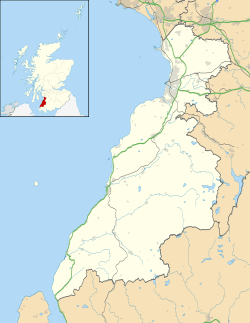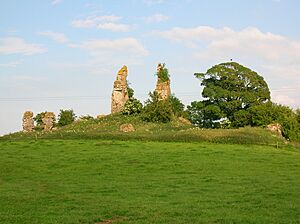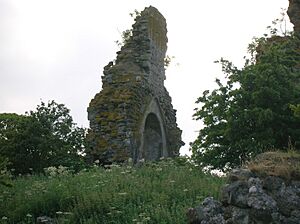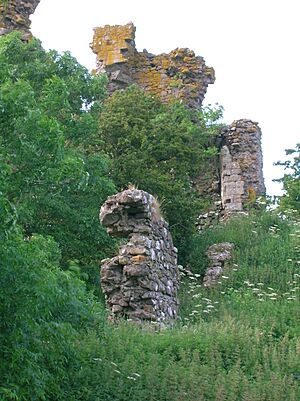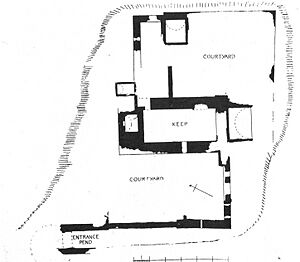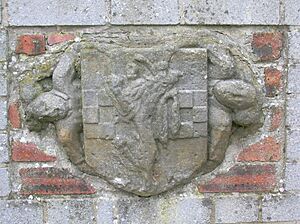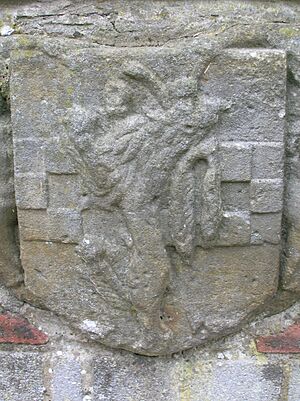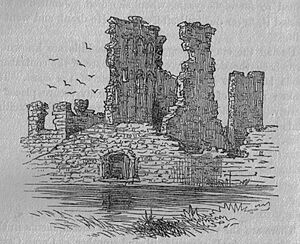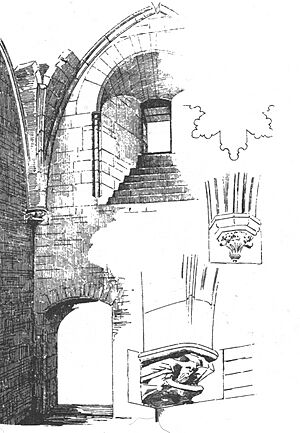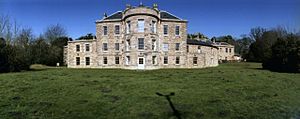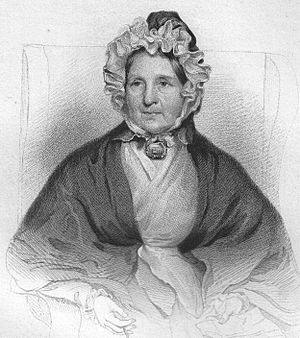Craigie Castle facts for kids
Quick facts for kids Craigie Castle |
|
|---|---|
| Craigie, South Ayrshire, Scotland UK |
|
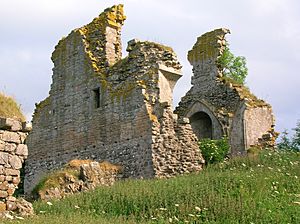
The keep of Craigie Castle
|
|
| Coordinates | 55°33′10″N 4°31′29″W / 55.5529°N 4.5246°W |
| Site information | |
| Controlled by | Lindsay clan |
| Open to the public |
No |
| Condition | Ruined |
| Site history | |
| Built | 12th century |
| In use | Until 17th century |
| Materials | Stone |
Craigie Castle is a cool old ruined castle in South Ayrshire, Scotland. It's about 4 miles (6.4 km) southeast of Kilmarnock and 1 mile (1.6 km) southeast of Craigie village. This castle is one of the oldest buildings in the area. It's so important that it's protected as a special historic site called a scheduled monument.
Contents
The Story of Craigie Castle
Craigie Castle, also known by its Gaelic name Caisteil Chreagaidh, was first built for the Lyndesay or Lindsay family. Around 1371, the castle passed to John Wallace of Riccarton. This happened when the last Lindsay heir was a daughter who married into the Wallace family. The Wallaces of Ayrshire then lived at Craigie Castle for many years. They moved to Newton Castle in Ayr in 1588, and Craigie Castle slowly became a ruin.
Some people believe that the famous Scottish hero, William Wallace, was born at Craigie Castle. They say he lived there for some years before his family grew too big for the castle.
What Did the Castle Look Like?
The castle ruins you see today are mostly from the 15th century. But some parts are even older, from the 12th or 13th century. Some experts think the main building was a "hall house" from the 12th or 13th century. This type of house had a large hall where people lived and ate.
The castle was surrounded by ditches and natural small lakes, covering an area of about 4 acres (16,000 m2). It had a fancy vaulted hall, which means the ceiling was made of curved stone arches. This hall was built over a basement. Inside, there was a round-arched doorway and a large fireplace added in the 15th century.
Craigie Castle had one of the best vaulted halls in Scotland for its time. It was as impressive as those found in old Scottish churches or abbeys. Many people believe Craigie was the most amazing building of its kind in Ayrshire.
Because the castle is so ruined, it's hard to know exactly what it looked like originally. But it seems it started as a simple rectangular building, like an early hall-house. Later, in the 15th century, new parts were built on top of the old walls.
The castle sits on a small hill between what used to be two marshes or lakes. Ditches were dug to connect these water areas, making the castle like an island. This made it very hard for enemies to attack, especially before gunpowder was invented. Today, you can still see crumbling walls and parts of the battlements. In the past, there were also underground rooms, but they are now filled with rubble. The main entrance was on the southwest side, with a drawbridge that is no longer there. There was also a round watch-tower to protect the entrance. Inside the castle walls was a courtyard, surrounded by other buildings.
In 1895, a record shows that a deep trench was dug to connect the two lakes, about 145 paces northeast of the castle. There were also other trenches and walls around the castle.
In 1863, it was noted that the castle was being repaired in the late 1600s. But part of the roof fell in, and after that, the castle was completely left alone. People admired how well the castle was designed for defense. Attackers would have been exposed to fire from many directions.
An old map from around 1600 shows 'Kragy' castle on a raised area with a clear entrance and surrounding woods. The road near the castle (B730) was once a main route, making Craigie an important spot for travel.
What is a Crannog?
Even in the 1800s, people could see what looked like a crannóg near Craigie Castle. A crannóg is an ancient artificial island, often built in lakes or marshes. This one was described as a "slight rise in the meadow" made mostly of stones. When the area was drained, an oar was found, suggesting it was indeed a crannóg.
Moot Hills and Borland Farms
Near Craigie village, there were "moot hills." These were special hills where important meetings or court hearings took place in old times. Every large estate would have had one.
There were also "Borland Farms" near Craigie village. The name 'Borland' might sound like "boar," but it more likely comes from "boor," meaning a servant. These farms were probably lands set aside to grow food specifically for the castle and its people.
Craigie Mains Farm and Famous Horses
At Craigie Mains farm, there's a special stone plaque from the castle ruins. It shows the combined coats of arms of the Lindsay and Wallace families. Some local people used to think it showed two wild men playing a game of draughts!
James Kilpatrick of Craigie Mains was a very famous horse breeder. He greatly improved the Clydesdale horse breed. He was known all over Britain and the world for his champion horses. Some of his famous champions included Craigie Litigant, Craigie Excellence, and Craigie Supreme Commander. In 1951, Craigie Mains had about 80 horses! James Kilpatrick often showed his beautiful Clydesdales at the annual Craigie Agricultural Show.
One of his most famous horses was the 'Baron of Buchlyvie'. Mr. Kilpatrick bought him for £700 in 1902. This horse was later sold for an amazing £9,500, which was a huge amount for a horse back then! The skeleton of this famous horse is now on display at the Kelvingrove Art Gallery and Museum in Glasgow.
A local poet, Matthew Anderson, even wrote a poem about Symington and Craigie, praising the famous Clydesdale horses from the area.
|
"The greatest place beneath the sky, |
The Lindsay Family of Craigie
In the 12th century, Walter fitz Alan, who was the Steward of Scotland, owned these lands. Walter Hose held his lands from the Steward. In 1177, Walter Hose gave the church of Cragyn to the monks of Paisley. His son, John, inherited the lands, and then John's son, Thomas. Thomas had no children, so his sisters, Christiana and Matilda, inherited the lands. Walter de Lyndesay, a knight, was Christiana's son. The male line of the Lindsays ended with John de Lyndesey, whose daughter married John Wallace of Riccarton.
The Wallace Family of Craigie
John Wallace of Riccarton became the owner of Craigie Castle around 1371 when he married the Lindsay heiress. From then on, Craigie was the main home for the Wallace family.
John Wallace was a high-ranking officer for King James II. He fought in the Battle of Sark in 1448 and was injured. He died at Craigie Castle about three months later.
In the late 1400s, the Wallace family asked a poet named Blind Harry to write a long poem called The Wallace. This poem told the story of Sir William Wallace, even though it was written 150 years after his death.
Many Wallaces of Craigie were important people. An Adam Wallace worked for King James III in 1468. Another John Wallace died in the Battle of Flodden in 1513. His brother, Adam, became a powerful leader in the local area.
In 1559, Sir John Wallace joined other Scottish lords and 2500 men to support the reformers.
Sir William Wallace, another family member, fought for King James VII (who was also James II of England). When the king went into exile in France, Sir William went with him. He fought in the Battle of Killiecrankie and died around 1700. His brother inherited the family lands, but they were much poorer because of Sir William's loyalty to the king.
The Wallaces of Craigie were also hereditary Bailies of Kyle Stewart. This meant they were the main local representatives of the King. In 1489, John Wallace even got permission to mine coal near Prestwick.
In 1770, Sir Thomas Wallace died. His grandson, Thomas Dunlop, inherited the title but sold the Craigie estate in 1783. He moved to England and took the name Wallace. His son, Major-General Sir John Alexander Wallace, was a soldier who fought in India, Egypt, Spain, and France.
The Wallaces of Craigie married into other important local families, like the Campbells of Loudoun. At Blair Castle, you can still see the coats of arms of the Blairs of Blair and the Wallaces of Craigie, dated 1617.
In the 1560s, the Wallace family gained control of Fail Monastery, an old religious building. However, it later passed out of their hands.
Wallace Family Coat of Arms
The coat of arms for Sir John Alexander Wallace had four parts. It showed a red shield with a golden lion and a border, and another part with a red shield and a checkered band of silver and blue. The supporters were two "savages," which were figures of wild men holding clubs. The family crest was an ostrich head coming out of a crown, holding a horseshoe in its mouth. Their motto was "Esperanza," which means 'Hope' in Spanish.
The Legend of the Fall of the Wallaces
There's an old story about the Wallaces of Craigie. It says that Sir Hugh Wallace, the Laird of Craigie, didn't follow the strict rules of the Presbyterians. He supposedly let his workers labor on Sundays and traveled openly on the Sabbath. Other local ministers complained to his own minister, Mr. Inglish.
The story goes that the Laird ignored their advice. One day in church, he even threw his sword at the minister, and it stuck in the wood behind the pulpit! The minister, after recovering, told the Laird that his "great stone house" would become a pile of stones that no one could repair. He also said that the Laird's son, whom he had high hopes for, would die a "fool." Soon after, when stonemasons tried to repair the castle, a large part of it fell down. This story might have some truth to it, as Sir Hugh was known to support the King's church, which was different from the Presbyterians, and they often disagreed.
Craigie House in Ayr
In the 1730s, a new home called Craigie House was built in Ayr. This was meant to be a replacement for Sir Thomas Wallace, who lived at Newton-on-Ayr Castle. In 1783, William Campbell, who became rich in India, bought most of the Craigie estate. His brother, Richard Campbell, inherited it in 1823, and the property stayed in the Campbell family for many years.
Ayr Town Council bought Craigie House and its estate from the Campbell family in 1940. The beautiful gardens that run along the River Ayr are now open to the public for free. The house itself is used as offices for the University of the West of Scotland.
Newton-on-Ayr Castle
The Wallaces built this castle, which was also known as Sanquhar, around the 15th century. However, King James V later gave it to Sir William Hamilton in 1539. Hamilton was a favorite of the Regent Arran and became the Captain of Edinburgh Castle.
In 1559, John Wallace of Craigie and forty others took the castle back by force. But they were made to return it to the Hamiltons. The Wallaces finally confirmed their ownership in 1598 and moved in soon after. The castle was badly damaged in a storm in 1701 and was completely taken down in the late 1700s. Nothing of this tower remains today.
Fun Facts
- The Eglinton Hunt, a group that hunted foxes, often visited Craigie's hills and glens in the 1900s.
- The small loch (lake) below the old manse (minister's house) was used for curling in the 1900s. You can still see the ruins of the curling house today.
- In 1584, William Wallace of Ellerslie owned lands near Helenton, including a tower and manor house.


